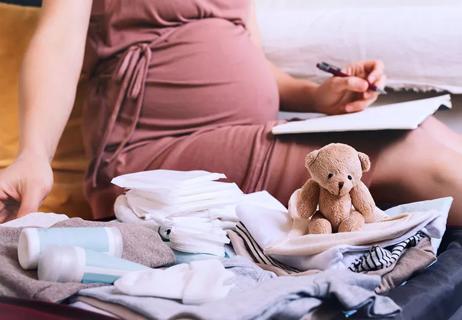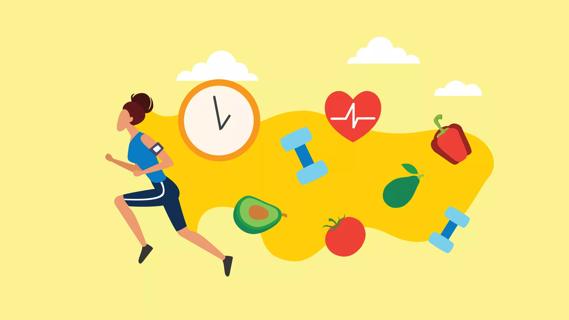Use a birthing ball for pregnancy exercises and to ease labor pain

When you’re pregnant, it may feel like aches and pains are taking over your body. It’s normal and expected.
Advertisement
Cleveland Clinic is a non-profit academic medical center. Advertising on our site helps support our mission. We do not endorse non-Cleveland Clinic products or services. Policy
A growing belly means it’s harder to move and sit comfortably. And as the fetus grows, it takes up more space. Your body adjusts, and pressure and stiffness set in.
Enter the birthing ball. A birthing ball can ease pregnancy discomforts and serve as a prop for pregnancy-safe exercises. And, as its name suggests, the big rubber balls are also helpful for every stage of labor.
“Birthing balls are so great for supporting your body during labor and helping you cope with the pain and pressure,” says nurse midwife Kelly Wilson, CNM. “They can really make a difference for an easier delivery.”
A birthing ball — also called a yoga, exercise or pregnancy ball — is a large, inflatable ball. They’re made of soft rubber and come in a few different sizes. The idea is yours should be the right size for you to sit on comfortably — with the bottoms of both your feet touching the floor and your knees bent at a 90-degree angle.
They’re common props in the gym, where people often use them for an added challenge in core exercises or pushups.
Then, there’s a type of birthing ball you won’t see at the gym. It’s more specifically used in pregnancy and labor. It’s called a peanut ball. It looks just like it sounds: Oval-shaped with larger bulbs on either end and a skinnier middle.
Advertisement
Birthing balls are useful tools throughout your pregnancy and even during labor. They can ease pain and pressure in your back, pelvic area and tailbone.
“During pregnancy, sitting on a birthing ball improves your posture and relieves pressure, which can help with aches and pains,” says Wilson. “Tilting your hips back and forth and side to side while you sit on the ball also keeps your hips and back mobile.” More mobility can mean less discomfort.
One study showed that birthing ball exercises during mid to late pregnancy reduced pain and fatigue in the waist. They also reduced the rate of episiotomy, a rare procedure where your provider makes a small incision at the bottom of your vaginal opening to help your baby come through more easily.
“During labor, a birthing ball provides support in various positions, as well as a lot of comfort,” says Wilson. Bouncing lightly and rocking your hips while sitting on the ball helps reduce and distract from pain.
In a study of people who had an epidural for pain relief during labor, using a peanut ball significantly decreased the length of labor. It also reduced the chances of needing a cesarean section (c-section).
When you’re in labor, your birthing ball can help ease discomfort as you prepare for delivery. You can try:
A peanut ball can be especially helpful if you have to lie down during labor. Wilson suggests these positions with a peanut ball:
You can use a birthing ball at any point in pregnancy or labor as long as you can do it comfortably.
And there’s no need to wait to try it out.
“Practice with it and see what makes you comfortable before you’re in active labor,” Wilson advises.
Particularly, if using pain medication isn’t part of your birth plan, you’ll probably be glad to have a birthing ball during labor.
“It’s a huge help when you’re coping with pain,” Wilson reassures.
Check with your hospital or birthing center if you plan to give birth at a medical facility. Make sure they have the type of ball you want to use, or plan to bring your own.
Advertisement
“We encourage you to stay active throughout pregnancy, as much as you can,” notes Wilson. “When it comes to using a birthing ball for exercise, you can do whatever exercises feel comfortable and don’t cause strain.”
Sitting on a birthing ball during pregnancy engages your core muscles.
“Instead of sitting on the couch when you’re watching TV, try sitting on your ball,” suggests Wilson. And while you’re sitting, you can bounce gently, do small pelvic tilts and circle your hips around to keep your lower back loose.
Try these stretches with a ball:
“You can use a birthing ball for exercise in any way that a non-pregnant person would, as long as it’s not causing discomfort,” Wilson states. “Listen to your body. And if you have any doubts or questions about what’s safe, be sure to talk to your care team.”
Advertisement
Learn more about our editorial process.
Advertisement

Babies aren’t great about scheduling, so be sure to pack a month or two before your due date

Losing belly fat can reduce your risk for chronic health conditions — try focusing on a diet high in lean protein, exercising regularly, reducing stress and getting quality ZZZs

It’s best to exercise before or after your fast, instead of during it

Absolutely! In fact, in many ways, exercise is key to recovery

The exercise — which you’ve probably been doing since grade school — can be intimidating, but proper form can help

Cardio is great for improving cognition, but strength and balance training are just as important

Exercise lowers risk for heart conditions, improves mental health and reduces visceral fat that can compromise your organs

Kids’ yoga can help kiddos become more aware of their physical, mental and emotional selves

Type 2 diabetes isn’t inevitable with these dietary changes

Applying a hot or cold compress can help with pain